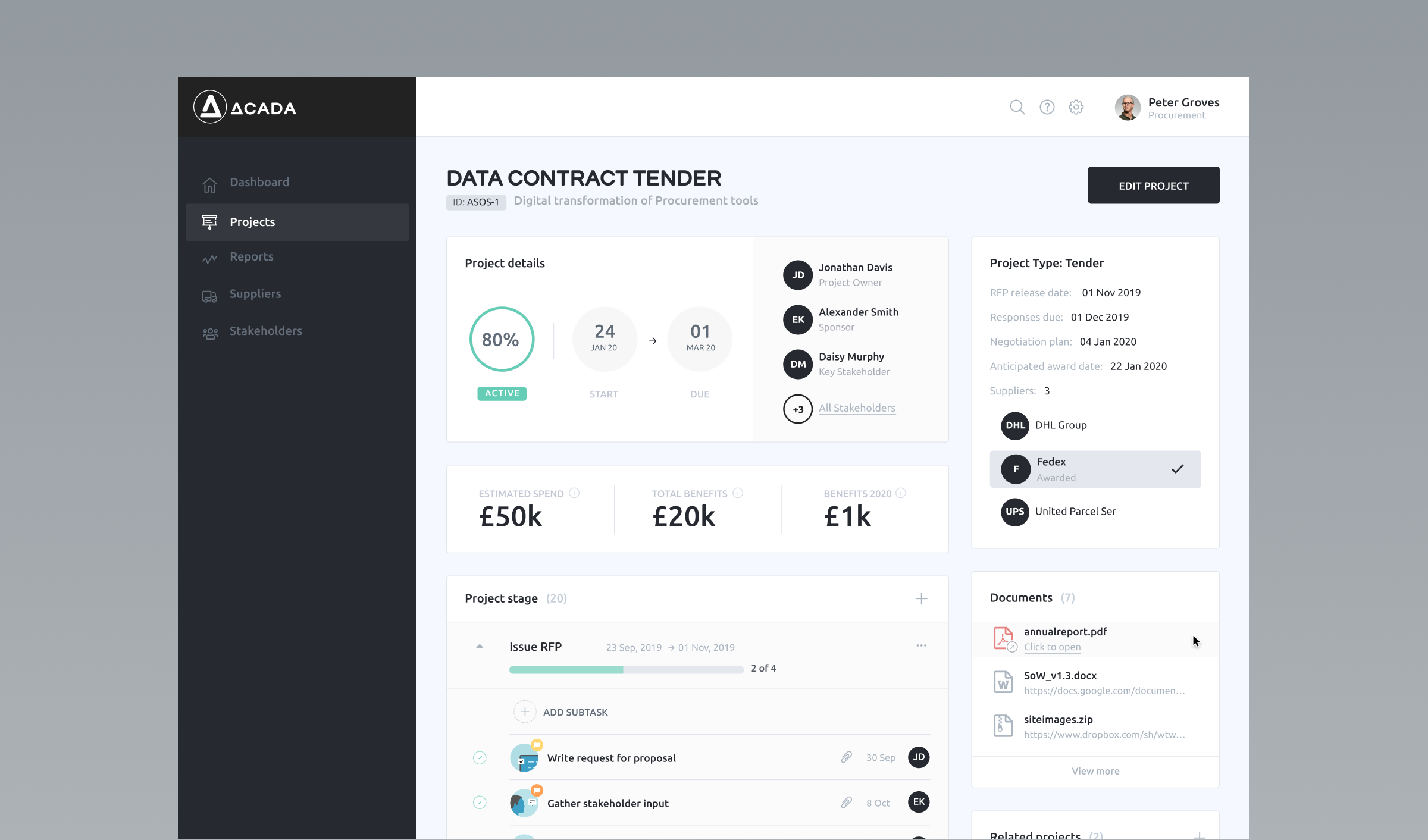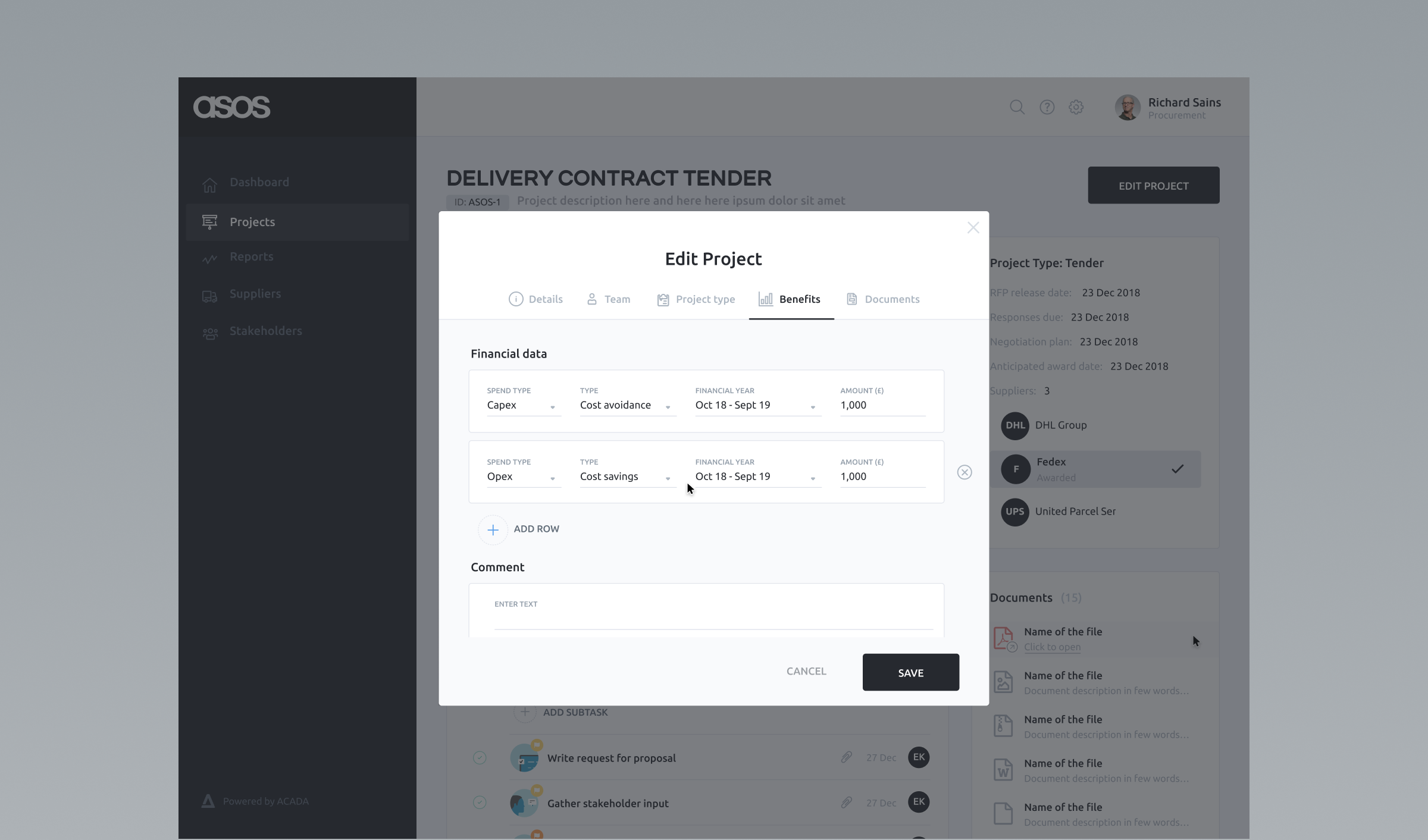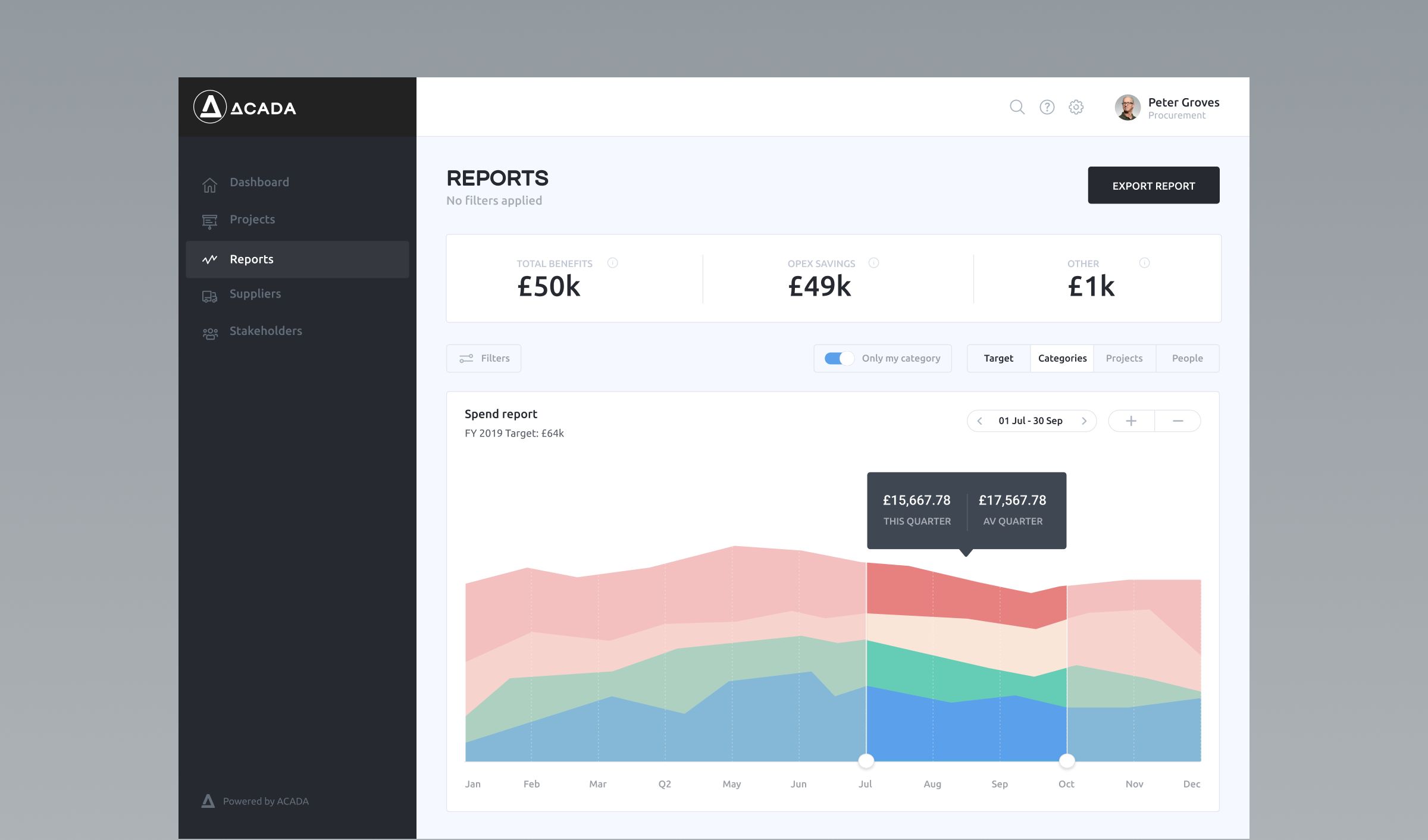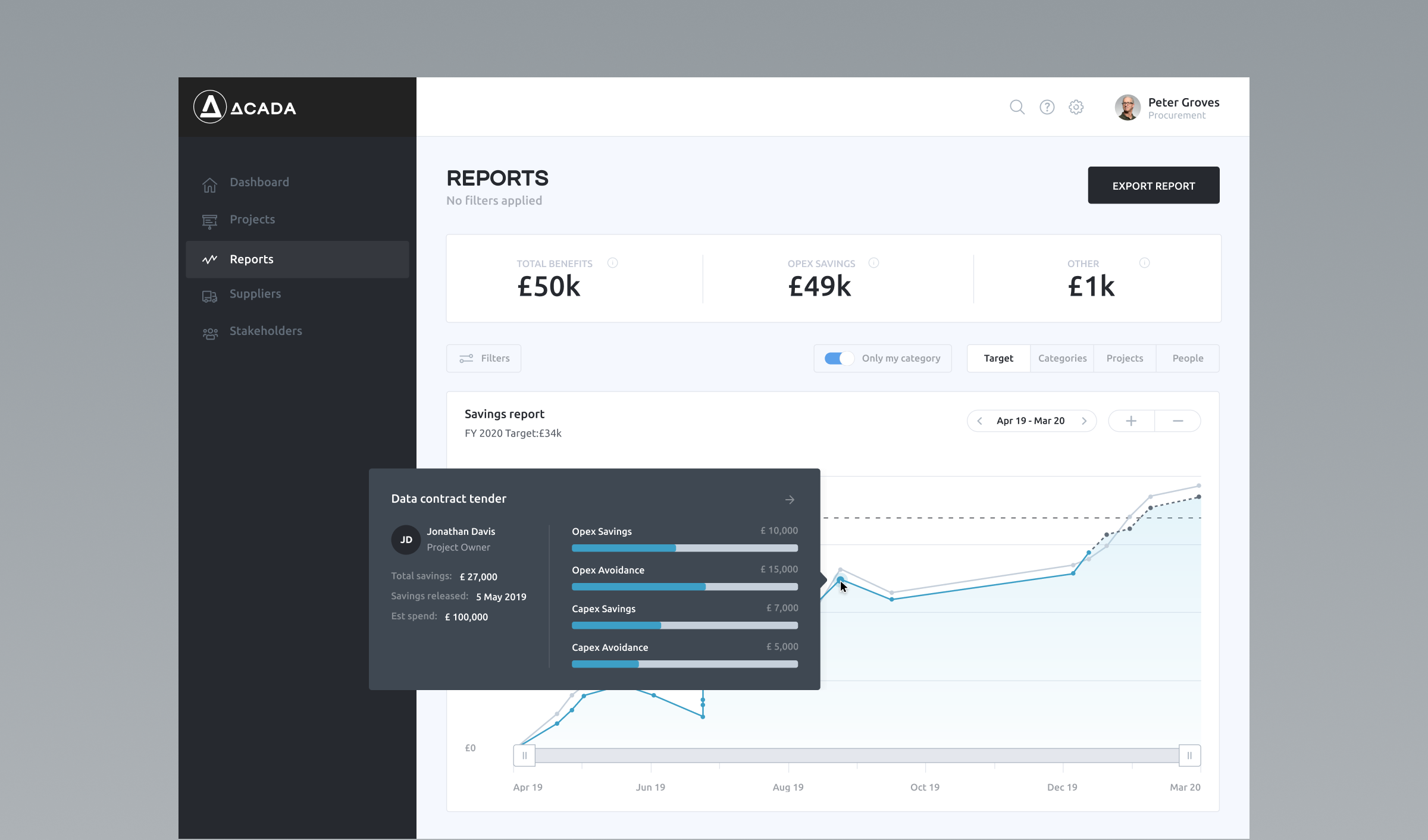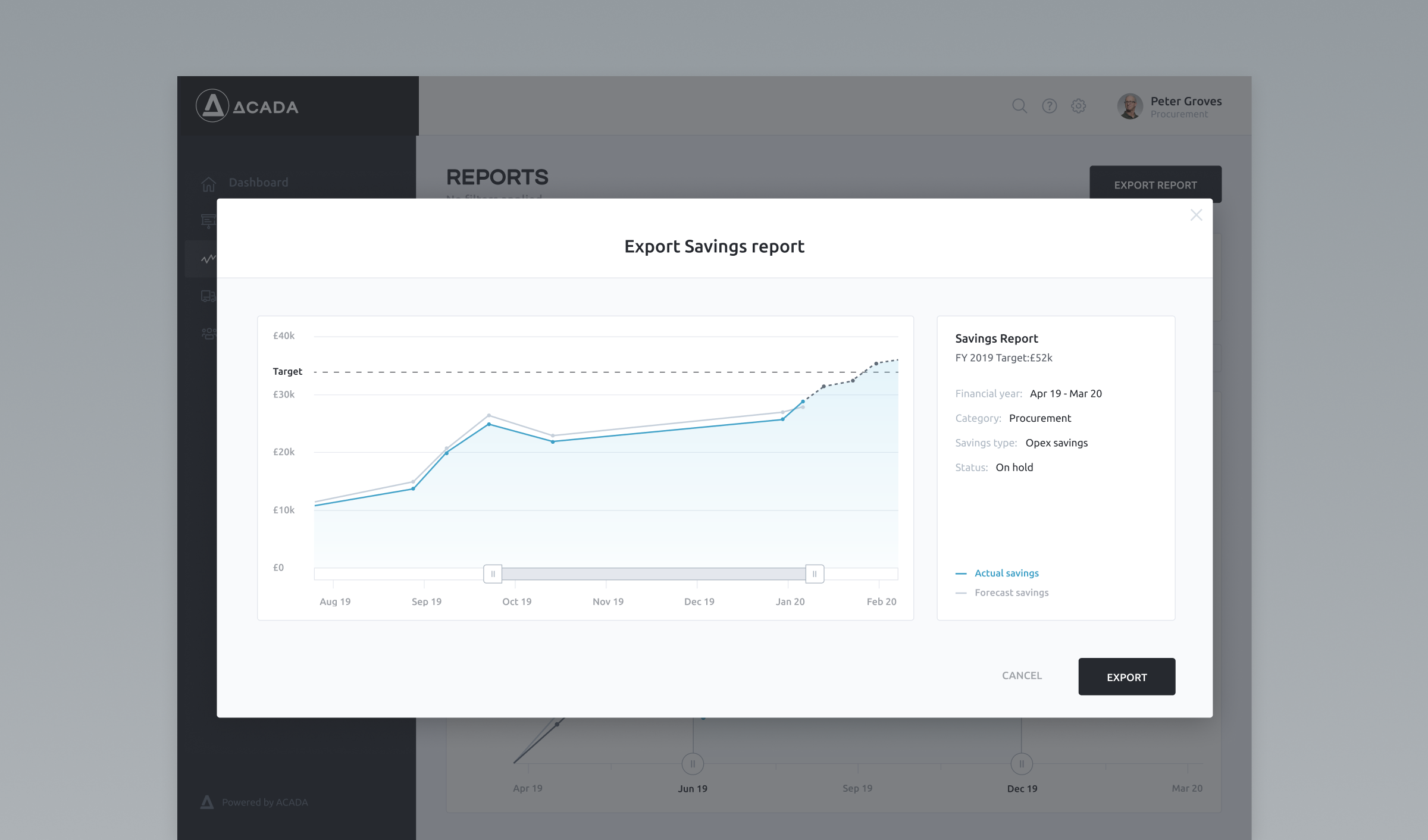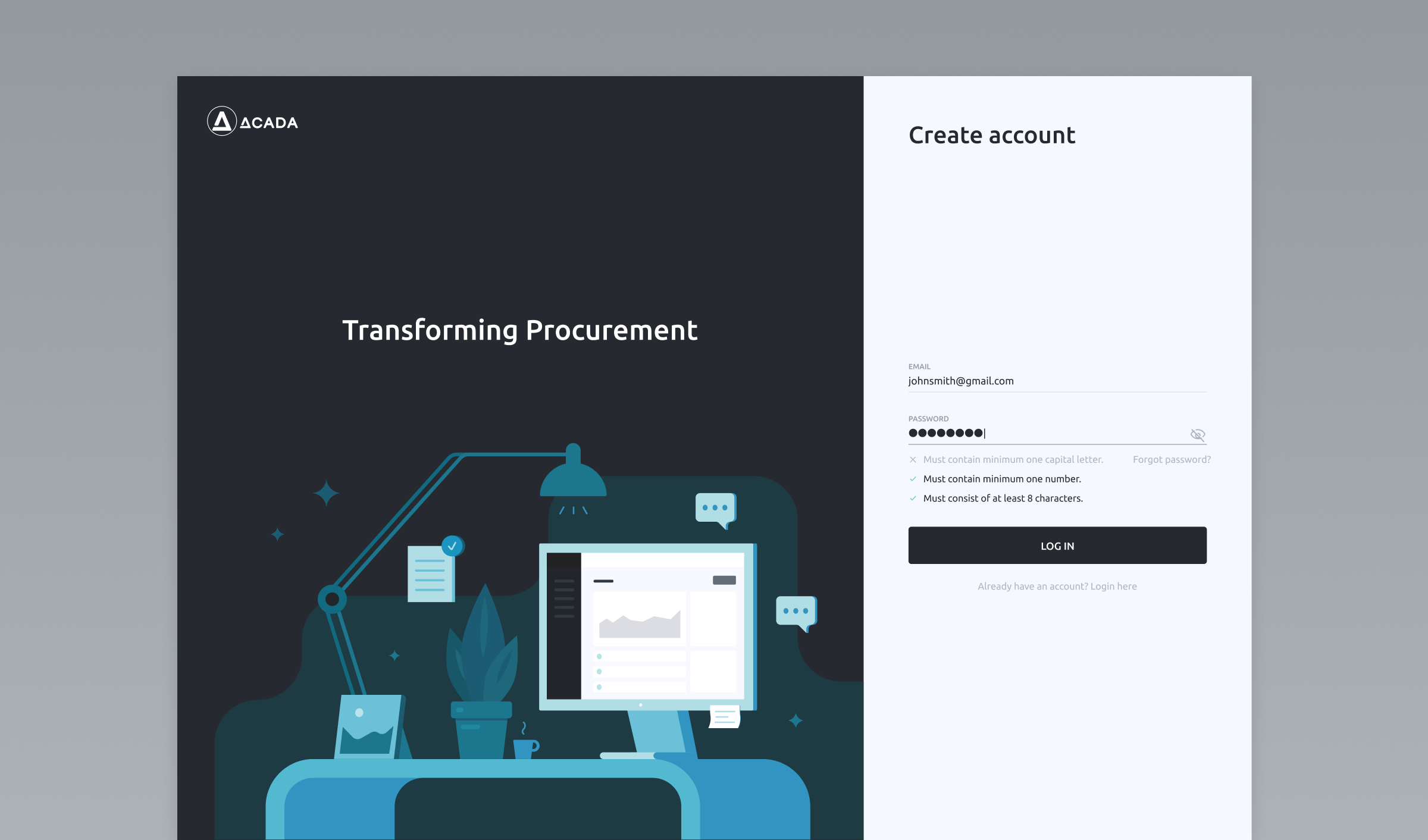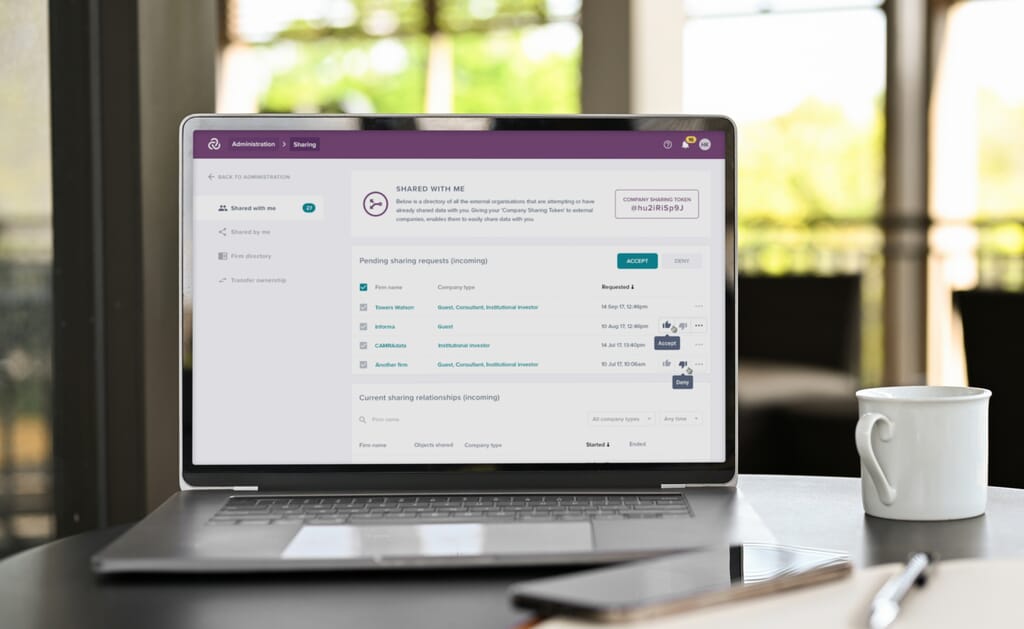
Overseeing supplier relationships and streamlining processes
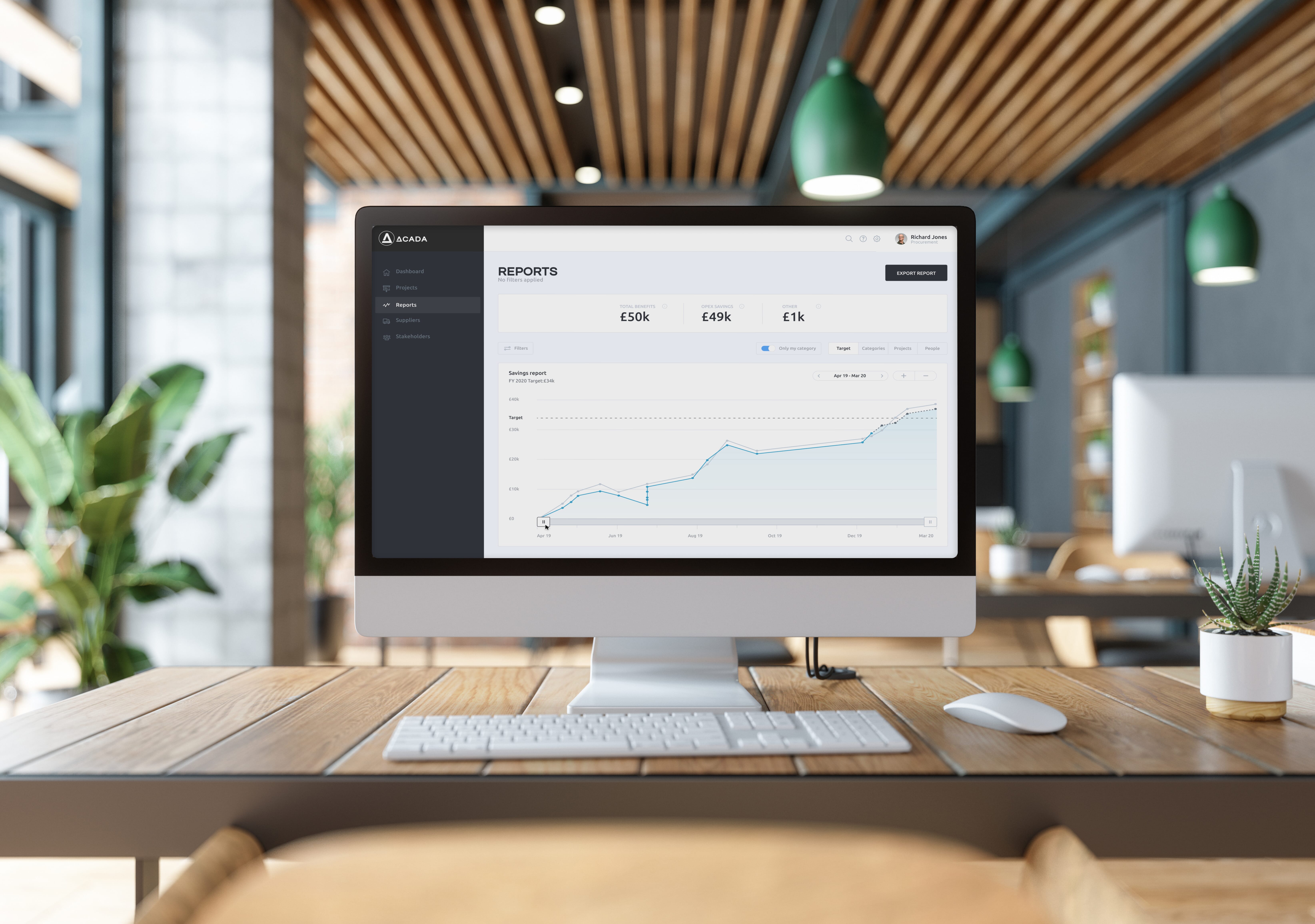
At a glance
Acada is a web app for managing procurement projects. We worked closely with the client to understand the user’s business processes, so we could provide a solution which allowed users to pull out key data, improve team task management and automate creation of projects. A key consideration was ensuring the system scaled well for use at an enterprise level.
Full Clarity worked on the full project from a clear slate, shaping everything from early user journey flows and wireframes to intuitive UX/UI design and full-stack development. The result is a platform that supports procurement teams with clear, efficient workflows.
Project type
Sector
Services provided
Technologies
User journey flows
We conducted comprehensive interviews with various stakeholders allowing us to capture key insights into daily workflows, pain points, and unmet needs. The primary issues identified were the difficulty in navigating complex supplier relationships and the inefficiencies in tracking project-related actions. Our UX research highlighted the need for streamlined user journey flows to minimise time spent on administrative tasks and to ensure that procurement teams could quickly access vital data.
Based on this feedback, we created detailed user journey flows that catered to different user roles, ensuring that each group had a tailored experience. This included intuitive pathways for project tracking, supplier management, and strategic planning. We wanted to new user interface to be designed to ensure that complex workflows could be easily understood and managed across different devices. Our flow diagrams outlined step-by-step processes, simplifying user interactions with the platform and reducing the cognitive load for end-users. This approach significantly improved the overall usability of the system, resulting in more efficient procurement and supplier management processes and really aided the UX/UI design work ahead.
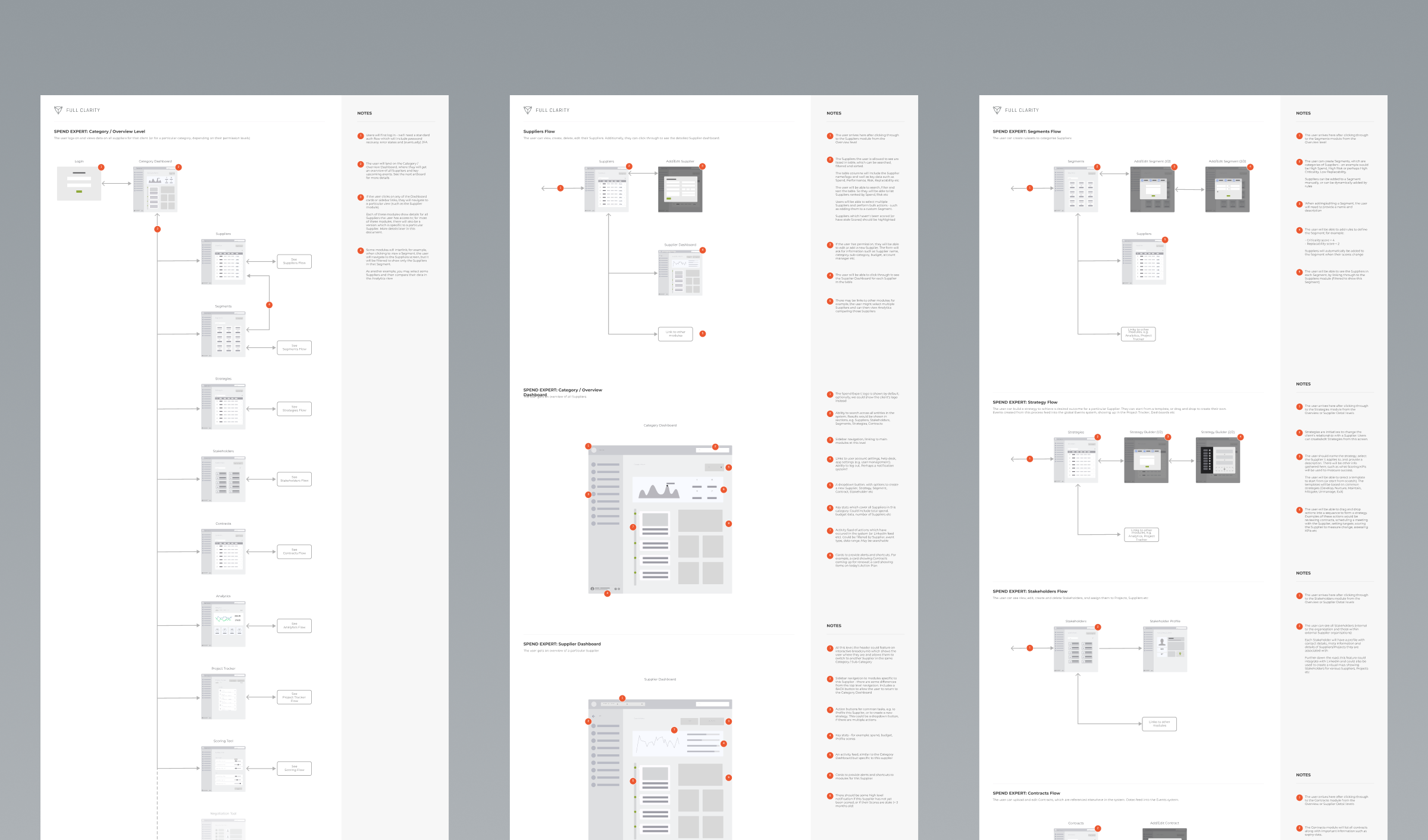
UX concept ideation
In the Concept Ideation stage we generated, explored, and refined innovative ideas for the platform’s user interface design and functionality. This involved sketching out detailed interaction patterns, and interface elements to ensure a seamless user experience. This allowed us to validate UX concepts early, ensuring that all aspects of the platform would meet the needs of its users.
In this phase, we meticulously sketched out every aspect of the Acada reporting system, focusing on user experience elements like filters, tooltips, zooming options, hover states, and colour coding. We considered every detail to ensure the reports were intuitive and flexible. For example, filters were designed to be dynamic, allowing users to narrow down by financial year, categories, and user actions. We explored how tooltips could offer real-time data explanations, while hover states highlighted key data points. Colors were thoughtfully assigned to represent categories and project statuses clearly. Additionally, zooming features were integrated to allow deeper insights into reports without overwhelming users.
By considering these interactive elements early in the process, we set the foundation that helped us validate our ideas and guide the development process, ensuring nothing was overlooked.
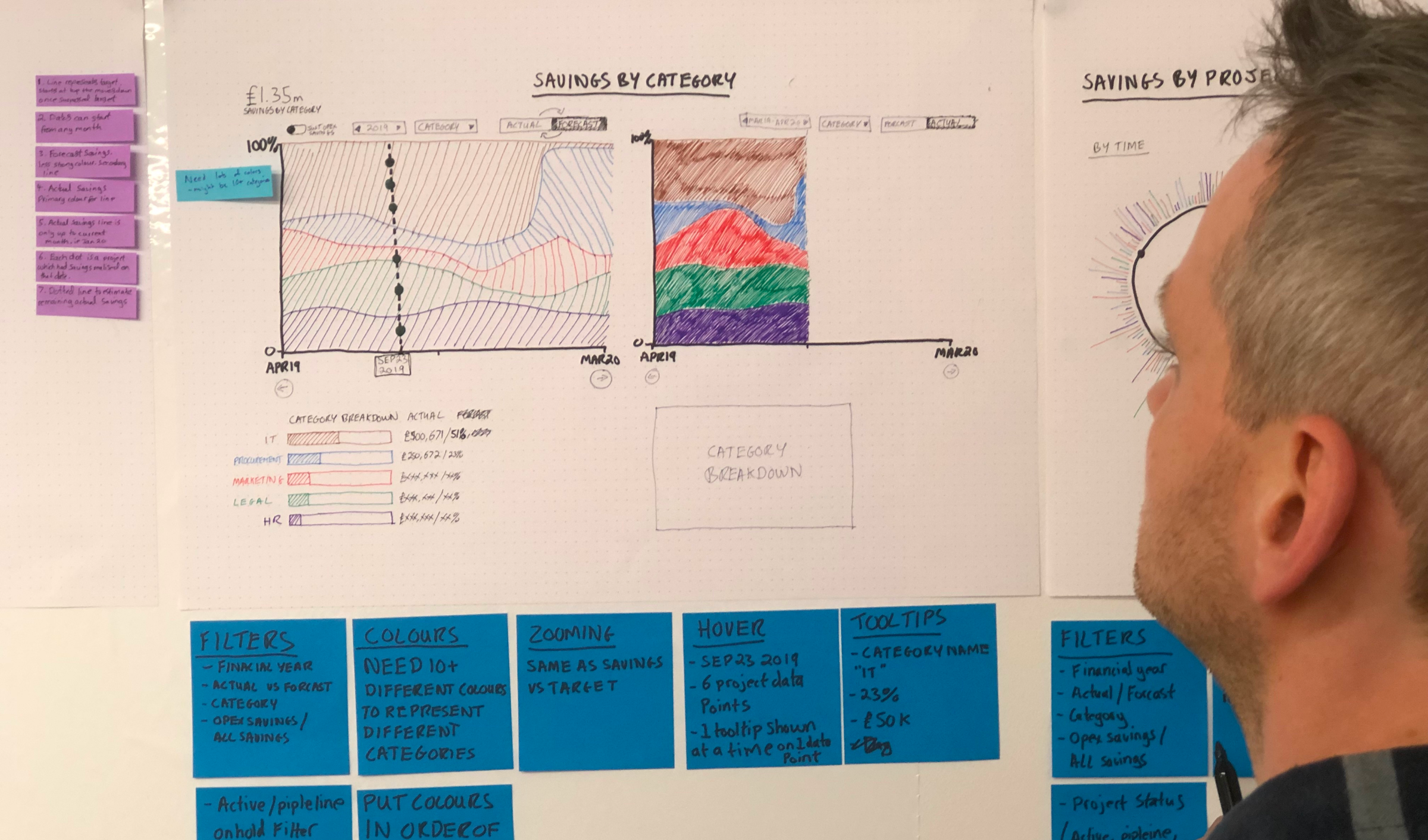
Supplier dashboard
The Acada platform features a sophisticated supplier management tool designed to help procurement teams effectively manage their supplier base. This module allows users to add, edit, and organise suppliers based on a variety of criteria, such as category, performance, and risk level. Key features include the ability to group suppliers by strategic importance and risk profiles, making it easier for procurement teams to focus on critical suppliers that have the greatest impact on operations.
Users can also perform bulk actions, such as assigning multiple suppliers to a segment or applying performance scores, streamlining the process of managing large supplier datasets. The supplier dashboard design displays essential data such as spend, performance metrics, and criticality scores, giving users a comprehensive overview of their supplier relationships. The platform includes advanced filtering tools that allow users to sort and search through supplier data efficiently. This ensures that procurement teams can quickly access the most relevant suppliers and take immediate action when necessary.
Additionally, the tool supports scoring mechanisms, enabling teams to assess suppliers on key factors such as risk, spend, and strategic importance, which feeds into the platform’s broader analytics capabilities.
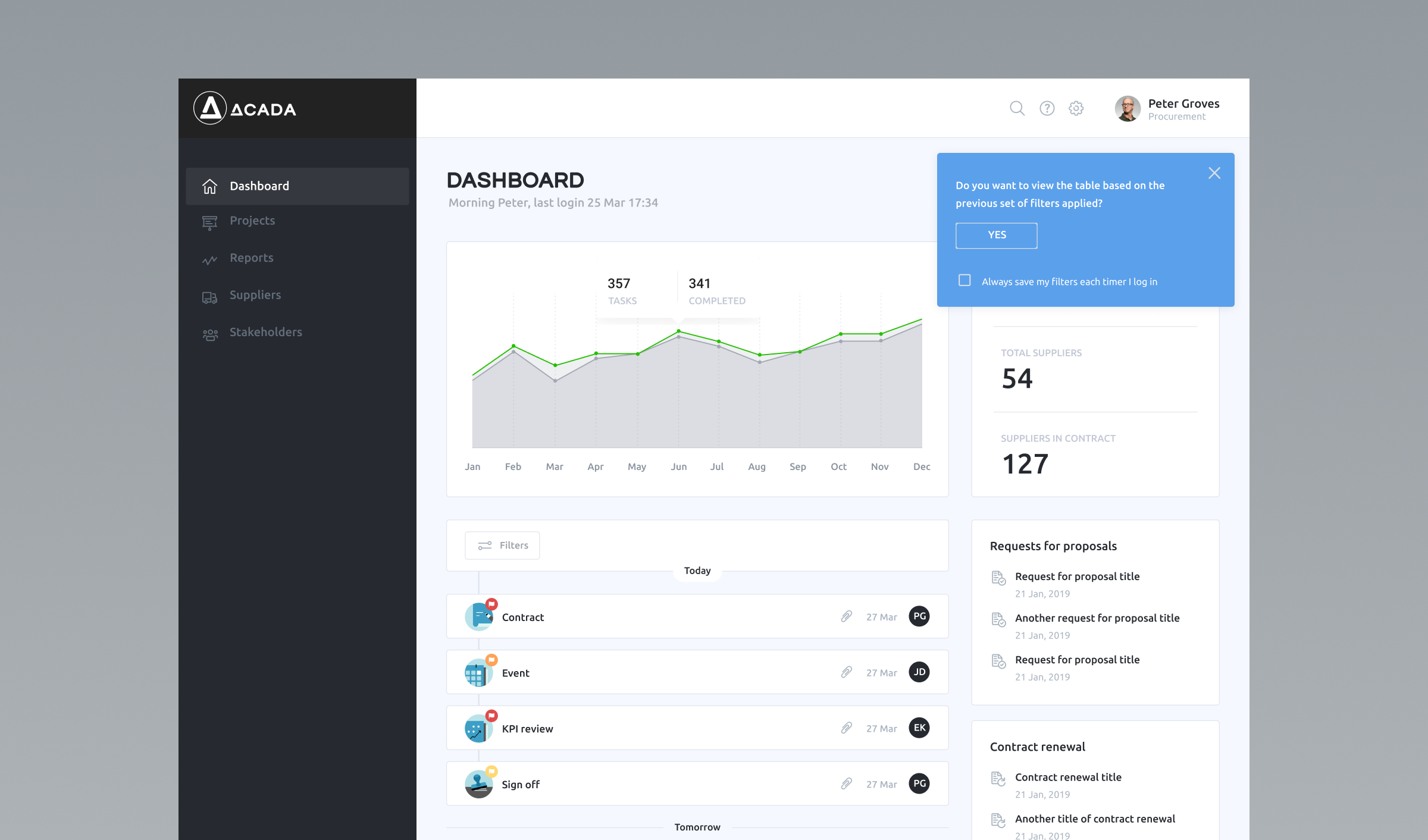
Project tracking and task management
A key element of the Acada platform is its powerful project tracking and task management system. This module allows users to create and manage procurement projects from start to finish, ensuring that all tasks, meetings, and milestones are tracked effectively. The project tracking provides a comprehensive view of all ongoing projects, displaying critical data such as task status, upcoming milestones, and due dates. Users can assign tasks to specific team members, set priorities, and upload relevant documents, creating a centralised hub for all project-related activities.
Each project includes a detailed metadata section, where procurement teams can input essential information, such as project value, stakeholder roles, and associated suppliers. To help teams stay organised and on track, the action management system includes a timeline view and Gantt chart functionality, allowing users to visualise project progress over time. This feature of the dashboard design ensures that no important deadlines are missed and provides transparency across teams. Additionally, actions such as contract renewals or KPI reviews can be assigned to specific team members, ensuring accountability and clear ownership of tasks. This module not only streamlines project management but also enhances collaboration within procurement teams.
Analytics and reporting data visualisation
To support data-driven decision-making, the Acada platform offers a robust analytics and reporting module. This feature provides procurement teams with the ability to generate detailed reports on various metrics, including supplier performance, spend trends, and risk assessments. The platform pulls data from multiple modules, such as supplier management and project tracking, to offer a comprehensive view of procurement activities.
Users can filter reports by metrics such as spend, risk, and strategic importance, and these reports can be shared with internal stakeholders to facilitate more informed decisions. The analytics reporting includes visual representations of key data, such as spend versus budget, supplier performance trends, and risk assessments, providing clear insights at a glance. The reporting tool also includes customisation options, allowing users to create tailored reports that meet specific business needs. These reports can be scheduled for regular updates or generated on demand, ensuring that procurement teams always have access to the latest data.
Additionally, the platform integrates scoring tools, enabling teams to track supplier performance over time and adjust strategies as needed. This module empowers teams to make more strategic decisions and improve supplier management.
Security and permissions management
Security is crucial in safeguarding sensitive procurement data and ensuring that only authorised users have access to specific information. Security is a critical component of the Acada platform, and it has been designed with robust protocols to ensure the protection of sensitive procurement data. The platform uses JWT-based authentication, ensuring secure login and session management for all users. AWS Cognito is employed to manage user identities, providing a scalable and secure solution for handling user credentials and permissions.
Each user is assigned a specific role (SuperAdmin, Admin, or User), and these roles determine the level of access a user has within the platform. For example, SuperAdmins can create organisations and manage all data, while Admins have control over projects, suppliers, and users within their organisation. Regular users can access and manage only the data related to their assigned projects.
Permissions are enforced at every level of the platform, ensuring that sensitive information, such as contract details or supplier performance data, is only accessible to authorised personnel. The security model also includes API gateway protections and encrypted data storage, ensuring that all interactions with the platform are secure and that the data is safeguarded against unauthorised access.
This layered approach is vital in preventing data breaches, ensuring compliance with industry regulations, and maintaining trust among users by protecting critical business information.

We’ve reduced administrative time by 80-90%. The system is incredibly user-friendly and requires minimal training, making the transition smooth and efficient.
Other client stories







